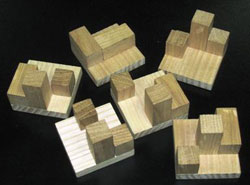| ENG RUS | Timus Online Judge |
NEERC 2010, Eastern subregional contest
Contest is over
C. Cube PuzzleTime limit: 1.0 second Memory limit: 64 MB  Petka's birthday present for Anka was an interesting wooden puzzle, which
he had made himself. The puzzle consists of six flat n × n squares.
Each square is lacquered on one side and has the other side divided into
n2 square cells. There are columns with 1 × 1 sections on some
cells; the height of each column is at most n.
Help Anka use these parts to assemble a lacquered n × n × n cube or
determine that this is impossible. The parts of the puzzle can be
rotated arbitrarily.
InputThe first line contains the integer n (2 ≤ n ≤ 20). Then the six
parts of the puzzle are described. Each part is described by n lines
consisting of n integers each. These integers are the heights of the
columns on this part. The integers in each line are separated with a space.
All heights are in the range from 0 to n. The sum of the heights of
columns on all parts of the puzzle is n3.
OutputIf it is impossible to assemble a lacquered cube from the described six parts,
output the only line “No”. Otherwise, output “Yes” in the first
line and then describe the scheme of assembling the cube. This
description should contain n blocks, each block containing n lines
with n integers in each line. The first block describes the lower
layer of the cube, the second block describes the layer lying
immediately on the lower layer, and so on. The last block describes
the upper layer. The first line in the description of a layer corresponds
to the back small cubes, the second line corresponds to the small
cubes located immediately in front of the back small cubes, and so on.
The last line describes the front small cubes. The small cubes in each
line are described from left to right. Each integer is in the range
from 1 to 6 and specifies the number of the part which the corresponding
small cube belongs to (the parts are numbered from 1 to 6 as they are given
in the input). If several schemes of assembling the cube are possible,
output any of them.
Samples
Problem Author: Stanislav Vasilyev Problem Source: NEERC 2010, Eastern subregional contest |
